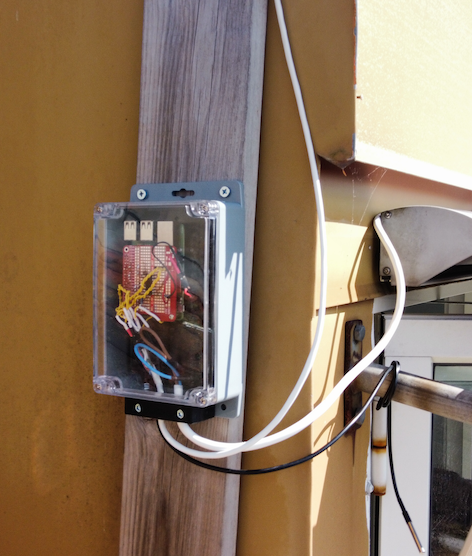A weather station based on the Raspberry Pi project Build your own weather station, implemented as a Balena multi container application.
| Raspberry Pi 3 | Weather station |
|---|---|
 |
 |
- Raspberry Pi 3
- Prototyping HAT for Raspberry Pi
- Sparkfun Weather Meter Kit
- One MCP3008 (8-Channel 10-Bit ADC With SPI Interface)
- SHT-30 humidity/temperature sensor
- Waterproof DS18B20 temperature sensor
- Two 4.7k resistors
The application is built using the following container and sensors:
- Anemometer - Anemometer (wind speed) sensor of the weather station.
- Humidity - Humidity and temperature sensor SHT-30.
- Raingauge - Raingauge sensor of the weather station.
- Temperature - Additional DS18B20 temperature sensor.
- Windvane - Windvane sensor of the weather station.
- Mqtt - Eclipse Mosquitto container which acts as message broker to which all sensors are sending their data. The Telegraf container reads from the Mosquitto queue and pushes the metrics into InfluxDB.
- Telegraf - Part of the TIG stack to consume and display sensor data.
- InfluxDB - Time series database storing the sensor data. This is the storage component of the TIG stack. It uses a default InfluxDB DockerHub image.
- NGINX
- API - the simplest of all containers in the weather applications. A Ruby based Sinatra used for exposing REST APIs for the weather app. Also,one of the simplest Balena containers, since there is no sensor and no special configuration.
- Grafana Dashboard - the Grafana dashboard displaying all weather data.
The wiring of the main components of the weather station (anemometer, windvane and raingauge) is as per Build your own weather station.
In order to inspect or modify the data stored in the Influx database you can connect directly to the influxdb container and start the influx CLI:
$ balena ssh <app-name> influxdb
? Select a device amazing-smoke (a36de3)
root@265d8274d16b:/# influx
Connected to http://localhost:8086 version 1.8.0
InfluxDB shell version: 1.8.0In order to get human-readable dates use the precision rfc3339 command:
> precision rfc3339
> use weather
Using database weather
> show measurements
name: measurements
name
----
humidity
rain
temperature
water-temperature
wind-direction
wind-speedTo select the entries of a measurement:
> SELECT * FROM "water-temperature"
2021-06-18T06:05:05Z DS18B20 22.0625 sensors
...To delete entries from a measurement use te DROP SERIES query:
> DROP SERIES FROM "water-temperature"